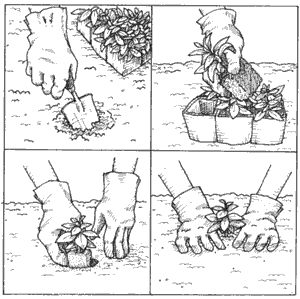The Right Place
Light - Impatiens does best in light shade or filtered, indirect light, but it can handle some direct sun if it is limited to about 2 hours a day, preferably in the morning. New Guinea types are even more tolerant of bright sun. Certainly impatiens’ brilliant colors show to best advantage in locations with some shade. Sunshine tends to bleach out paler impatiens flowers.
Soil - Like most flowers, impatiens prefer moderately fertile, well-drained soil, but they will accept poor soil too, which is another reason they are so popular. They are also tolerant when it comes to soil acidity, accepting a fairly broad pH range of 6.0 to 7.5.
 |
Planting Impatiens Seedlings
Plant homegrown or store bought seedlings outdoors well after danger of frost is past and the soil is warm, at least two weeks after last frost. If you buy seedlings choose young plants that are bushy and in bud, but not in bloom. Those that have already bloomed may "stall" and quit blooming for a few weeks after they are planted.
Plant on an overcast day, or late afternoon on a sunny day so that the seedlings are shielded from hot sun while they recover from transplant shock. Clear the planting area of weeds and debris. With a trowel dig down 6 or 8 inches and turn over the soil all over the area, breaking up the clumps and removing any stones. If the soil is thin and silty, this is a good time to dig in some organic matter such as peat moss or chopped leaves to it to help it hold moisture. Smooth the planting area and then dig a hole for each seedling about the size of the small container it is in and about 10 inches apart.
Pop each seedling out of the container, taking care to keep as many roots as possible and set it in a hole, making sure that it is at the same depth in the ground as it was in the container. Press loose soil around the seedling gently and water. Annual plants such as impatiens have shallow roots and need frequent follow-up watering after planting. A 2 or 3 inch mulch layer of chopped leaves, shredded bark or something similar helps keep the soil moist. Some yardeners pinch back the new seedlings a couple of inches every few weeks to encourage the plant to develop more branches and look bushier. This is not essential.
Growing Impatiens In Containers
Impatiens are suitable for planters sitting on the deck or patio or in hanging baskets or windowboxes, as long as they are in partial shade. Be sure to fill containers with good quality soilless potting mix rather than garden soil. This mix is lighter, drains better, and is sterile so that plants avoid disease problems. Since it does not contain soil and its nutrients, mix in some slow-acting granular fertilizer when you plant or every few days water them with a very dilute liquid fertilizer added to the water.
Propagating Impatiens
By Rooting Impatiens Stems
Impatiens plants are easily reproduced from stem cuttings placed in a glass of water on the windowsill. For rooting lots of stems use shallow pans or pots of damp vermiculite or perlite. Choose sturdy, non-flowering stems with at least 2 leaf nodes on them. These stems are likely to be from 3 to 6 inches long. Dip the ends cut from the plant in rooting hormone, (available in garden centers), then insert them into the moistened vermiculite about 2 inches apart. Make holes for them in it with a pencil, slip the stems in, then firm the medium around each one. Covering the pots with plastic assures that the cuttings have moisture. Set them in bright light, but not direct sun. The cuttings will take from 2 weeks to a month to develop roots. If they are set on a radiator or some other source of heat, they will root more quickly. Then plant them in the yard or, if it is winter, in a pot to enjoy indoors. For information about propagation equipment go to the Plant Propagation Equipment section of Yardener’s Tool Shed.
By Growing Impatiens from Seed
While impatiens seeds can be sown directly onto the soil outdoors, their slow rate of growth makes this impractical in the North where cool springs delay planting. However, if you have the inclination and the equipment for starting seeds indoors, start impatiens six to eight weeks before the approximate date when the final frost hits your area each spring. It is best to use a soilless mix designed for seed starting. Impatiens have very tiny seeds, so they don’t need much soil over them--no more than 1/8 of inch layer of very fine soil mix. You can even just leave the seed on top of the soil mix and then cover the seed-starting container with plastic wrap to keep the humidity high. For details about starting seeds indoors and out, see Starting Plants From Seed and check out Seed Starting Equipment and Supplies in Yardener’s Tool Shed.

